BATTLING BOY GN ($15.99, FirstSecond Books)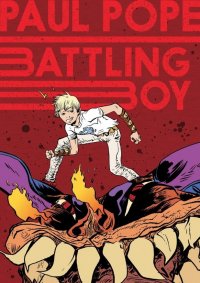
By Devon Sanders
The mark of a great read is when you want to share it with others…
No. The mark of a great read is when you want to go back and buy one for yourself so that you don’t have to share it with others.
That said, I’ll be giving copies of writer/artist Paul Pope’s excellent Battling Boy GN to my girlfriend’s eight year old son (who’s new to comics and loves them) and to my 13 year old nephew, who doesn’t really like comics but loves a good adventure story.
Battling Boy GN, Part One of Two, is a brilliant and kinetic take on the hero’s journey that practically dares ALL that enter its world not to become a comics fan.
In the city of Arcopolis, children are swept away from it’s streets by fiendish flying ghouls while monsters smash and tear things apart on a nearly daily basis. Nerves are raw and the city’s lone hope is it’s protector, the dark and mysterious science hero, Haggard West… who dies almost one-tenth of the way into the book.
It was a very heroic death, though.
All hope in Acropolis seems lost. High above the clouds, in a dimension man wasn’t meant to know, something wonderful is about to happen. An unnamed hero, the greatest of all heroes, returns home to prepare his son for his destiny. On the event of his thirteenth birthday, it is time for his son to go on a “ramble”; a time where gods walk the earth, defend its people and find the stuff that gods are truly made of. The thing is, Battling Boy was sort of expecting to… you know… hang out with his other god buddies, open gifts and sorta just… be. With almost no warning, a 13 year old boy is thrown from the heavens armed with little more than heritage, an invisible credit card, a traveling cloak, gauntlets and twelve t-shirts that imbue him with the strength, cunning and prowess of the creatures of earth and legend. With these things, a young god boy must find what he’s made of in a world of monsters and men. The results are nothing short of wondrous.
Paul Pope proves once again to be one of comics’ greatest storytellers. With dialogue that’s at times both appropriately ridiculous and fitting, Pope’s Battling Boy is full of great father/son moments that any fan of Marvel’s Thor or DC Comics’ Orion will instantly know and love. Pope provides a true moment of pathos within the death of the very human protector of Arcopolis, Haggard West. Upon his death, he leaves behind a grieving daughter, Aurora, who wants more than anything to rise to her father’s level of heroism; a clever bit of storytelling there and one that absolutely reeled me in.
Pope’s artwork is as fun and as great as ever. Pope’s Battling Boy is full of immaturity and swagger and well, looks every bit the 13 year old boy. In the story’s design and pacing, Pope shines. Every line drawn feels needed. Imagery is bizarre in places and fantastic in others yet all are fitting, making for one of my favorite comics reads in a very long time.
Battling Boy is what I expected and more; I finished this volume with the best feeling a reader can have. I didn’t want it to end. It will carry over, I hope, at least two more times.
I’m looking at two copies of Battling Boy with two very good guys’ names on them right now.
Rating: 




Out of a Possible 5 Stars
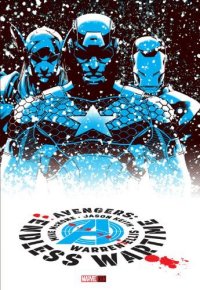 Avengers: Endless Wartime HC (Marvel, $24.99)
Avengers: Endless Wartime HC (Marvel, $24.99)
By Adam X. Smith
Okay, disclaimer time again.
Firstly I should point out that fellow Thor Comic Column writer Devon Sanders was originally planning to write a review of this at some point – Diamond apparently fucked up and sent a bunch of copies out to a bunch of stores and some reviewers early by mistake – but for reasons I’m not 100% on, that is no longer the case. I however managed to get mine shipped over to me last Thursday after paying for it less than a day before. The wonders of Amazon, I know. Which of course suits me fine, but that brings me to Point The Second.
As those observant readers will no doubt have picked up on, I have had nothing short of a man-crush on Warren Ellis for lo these many years. Though my love of his work was not my first (Jeph Loeb and Tim Sale were that, for the record) nor the most forgiving (Alan Moore, visionary though he is, has a rare tendency at times to be fucking ponderous, man), Ellis’ strength at bridging the divide between the mainstream tights and capes crowd and the futurist/deconstructionist intelligentsia whilst consistently writing books that do not suck places him in my heart somewhere between the onward march of the unapologetic geek new order and the fiery confrontational spirit of the punk, the outlaw, the gonzo journalist – indeed, if Alan Moore can be said to be comics’ answer to William S. Burroughs, Ellis is without a doubt its Hunter S. Thompson.
All this to say, I fucking love Warren Ellis, and as much as I may try to give this a fair review, I am unfairly biased in his favour, though admittedly for the best of reasons. So if you just want to know if the book is good or not, feel free to skip to the end and pay no further attention, but if like me you’re a stubborn dick and you actually give a shit about my opinion, let’s keep this train a-rollin’.
As one of the writers behind some of Marvel’s best storylines and titles from the middle 2000s – from his definitive retool of Iron Man with “Extremis” through his work on Nextwave, Agents of H.A.T.E. (for me, still his high-watermark with the company and a book I will never shut up about) and his Civil War tie-in run on Thunderbolts (rebranding them closer to a morally toxic, media-savvy Suicide Squad) to doing the seemingly impossible by topping Joss Whedon’s run on Astonishing X-Men, it’s no surprise they went with Ellis as the writer to launch their fledgeling Original Graphic Novel line, intending to redress the disparity in quality and quantity of Marvel’s work reaching the Waterstone’s and coffee table book-reader demographics.
And golly-bob-howdy, they’ve come to the right place, because if there’s anything that can be said about Nextwave or Astonishing that I’ve not already blurted at people’s faces, it’s that Warren Ellis’ work is a gift to anyone looking to get into the book design side of comics. Every facet of the presentation of the material in Endless Wartime is a treat for the eye: Mike McKone’s bold but nuanced lines, the discreet but sumptuous, almost but not quite letterboxed format of the panels themselves, the minimalist front and back cover art that comes across as somewhere between the starkness of Frank Miller’s Sin City with the clean simplicity and elegance of a Peter Saville album cover. It even has a page with what I can only assume is a (possibly faux) style guide for the typeface and graphic elements that constitute the Avengers logo and title lettering, for apparently no other reason than it looked cool enough to justify putting it in.
Just as “Extremis” was a rebrand of the Iron Man formula that brought his origin and exploits closer to the present day in the name of relevance whilst not shying away from giving his personality a much needed shot in the arm, setting the stage for the eventual successes of the Marvel Cinematic Universe, and in much the same way the Marvel NOW! rebranding effort has yielded a noticeable trend of making the comics more like the films, this iteration of the Avengers is clearly taking its cues from the character development of the film canon, whilst the characters are still clearly themselves. Steve Rogers lacks the boyishness of Chris Evans, for sure, but the work Evans and Joss Whedon put into making a potentially bland character interesting is hovering in the background. Cap is living in a world he doesn’t understand, and when the threat emerges, it is like he’s reliving his past in the same way one might expect to feel about an open wound.
Also, while the team is clearly still highly dysfunctional as in Joss Whedon’s film, they are at least acclimatised enough to working together that you could be forgiven for seeing this as an unofficial, well produced mid-quel to the unfolding Phase Two of Marvel’s Glorious Nine Year Plan.
This is to be expected: this isn’t a scrappy band of metahuman nobodies with no expectations to live up to like the Nextwave squad, or a gang of shock-collared psychopaths with exceptionally good PR like the Thunderbolts – these are the fucking Avengers.
So naturally there are no scenes of Emma Frost walking around half-naked and talking about psionic S&M and shoes, or Logan grumbling about wanting beer*, but Ellis still gives us little character moments worthy of the canon, like the banter between Captains Marvel and America regarding the rivalry between Regular Army and Air Force personnel, or Hawkeye being the comic relief butt monkey for the duration this time round, or that he and Black Widow and even Tony Stark have been considerably nerfed down a few pegs whilst still remaining resourceful as hell.
Without spoiling the plot, this story comes the closest to being a proper Warren Ellis book with a mainstream paintjob, and while McKone’s art is at times a little too repetitively staged, the quality of the overall book, the writing, the design, the atmosphere it creates are all balanced in a way lesser comics never can.
And for those who are likely to bitch about the fact that I rate this as almost perfect and tore down Jupiter’s Legacy as boring and derivative (which it is), kindly go and disembowel yourself with a wooden cooking spoon. It’s not about reinventing the wheel – in this case, there wasn’t anything in need of reinventing, and Ellis knows it! If your stated goal is to reinvent the wheel, and you don’t come back with something better or else as good as that – like say, a jet pack or a flying car – then you’re a time-waster and an arsehole.
Avengers: Endless Wartime doesn’t need me to do it any favours – I was on board from word one – but for those still not sure, let me put it this way.
Back in the 2000s, Warren wrote an episode of the cartoon Justice League Unlimited called “Dark Heart”. That episode gave us both an epic action storyline with interesting concepts like nano-technology and the future of biomechanised warfare, and the image of Ray Palmer clambering into Wonder Woman’s cleavage in order to better smash monsters to bits, launching a thousand GIFs as a result. But it was also the closest we got to a TV version of Global Frequency, his X-Files/CSI mash-up that involved combating bizarre threats to national security that the world governments would never actively own up to being responsible for in the first place.
This book, in many ways, feels like Ellis taking that thread of his work to its logical conclusion, and if after all that you still shrug and walk away, you have no taste and should go back to drilling holes in your skull with a mechanical pencil: I’m Adam X. Smith, and fuck all of you.
*I am saddened that we’re likely to never get to see Logan, as played by Hugh Jackman, transition into a role – however brief – as an Avenger. Even as an older man, he presents an interesting contrast to the current cinematic roster. Plus I want to see a Wolverine/Hulk fight which isn’t animated.
Rating: 




Out of a Possible 5 Stars
Superman/Wonder Woman #1 ($3.99, DC)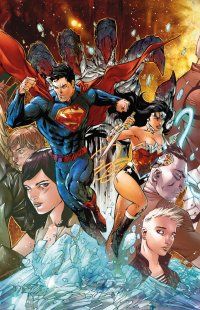
by D.S. Randlett (@dsrandlett)
Here are the words that are probably most uttered by the discerning mainline DC Comics reader when they are not reading Batman, Green Arrow or Wonder Woman: “Shit or get off the pot.” The romance between Superman and Wonder Woman serves as a sort of archetype of what the New 52 has been until now (while titles like the three I mentioned, among some others, show us what it can be). The romance, like much else in the New 52 seems to come from a desire to shake up the iconography, but very rarely have these shake ups grown out of story. Longtime readers of this column will know that I’m a Superman fan first and foremost when it comes to this stuff, and as a fan I’d be more than happy to see certain changes, reboots even, if they were fun to read and felt natural to the character and his stories. As a fan of the character, what frustrates me is not variances on canonical stories or motifs, but rather hearing stories about good writers whose good ideas were stymied by an editorial that’s overly concerned with protecting “the brand.”
So now Superman and Wonder Woman are dating, which I guarantee you would have been anathema to DC if a creative team had thought of and built a story around it. I am not against this per se, especially since I’ve never gotten the sense that this was a permanent thing. There have even been some nice moments to come from this, like a moment in Scott Lobdell’s otherwise unremarkable run on Superman where Superman admits to himself that he is in love with both Wonder Woman and Lois Lane. That’s the kind of thing that happens in life, and thus is ripe material for a Superman story. But it’s all in the telling, and so far the telling has not been good. At all. The now infamous first kiss happened following an execrably written scene in Geoff Johns’ Justice League, and after that all this romance has had is a series of moments. This storyline hasn’t been bad because that story should be off limits, it’s been bad because DC hasn’t given it the dignity to be a real, honest, and human story instead of the headline grabber that it was conceived as.
Which brings us to Superman/Wonder Woman. The question here, of course, is if DC is finally turning this dynamic into an honest-to-god story. To this end, they’ve enlisted writer Charles Soule and artist Tony Daniel. Soule’s script is nothing revolutionary, but it’s well structured and efficient. Soule has the unenviable task of crafting what is, no bones about it, a superhero action yarn while getting the reader to believe this relationship. And, wouldn’t you know it, he kind of pulls it off by doing something both honest and unexpected. Soule portrays a relationship based on a sense of companionship (both characters are alone in the world in their own ways) and a sense of animal attraction, and this is believable, relatable, and human. More than that, he writes this relationship as something that cannot last. Problems, disagreements, and signs of incompatibility are rearing their heads, and that is certainly relatable, but also a seed for good drama. The superhero half of the story underwhelms somewhat, as it follows the ever familiar “routine rescue goes awry” pattern, and it relies on the appearance at the very end of a villain who never ceases to make me roll my eyes. It presents a weak hook, it would seem both for the writer and his readership, and this first issue is saved by Soule’s ability to get his hooks into a relationship that no one in the New 52 stable has been able to write.
Artist Tony Daniel strikes to opposite balance. To be honest, I’ve never been his biggest fan, but I have to admit that he’s improved his style pretty drastically over the past year and change. I remember when he was a rising star during the Infinite Crisis days and he came off as sort of a lite version of Jim Lee. These days, he’s presenting a style that’s more unique to him, with cleaner, more fluid lines and lots of momentum in his action scenes. He’s still a superhero artist through and through, though, and his work in those scenes is actually quite dynamic and good, with Wonder Woman in particular getting lots of really cool money shots. There are other scenes that call for a lighter touch, and Daniel doesn’t pull that off nearly as well. If this is going to be a doomed love story, voluptuous romanticism and melancholy will be orders of the day along with superhero action, and it might prove tough for Daniel to foot that bill.
I would hesitate to put Superman/Wonder Woman on the shelf next to Green Arrow or Wonder Woman, but all told it’s a solid experience that (so far) manages to do what has evaded an entire comic book line: make a romantic entanglement between two of superhero comics’ biggest icons feel like an actual story rather than a simple gimmick.
Rating: 




Out of a Possible 5 Stars
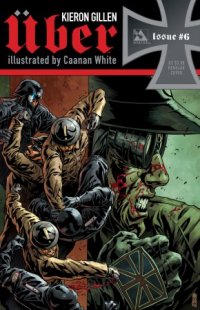 Uber #6 (Avatar, $3.99)
Uber #6 (Avatar, $3.99)
By Jeb D.
Following the release of Schindler’s List, Steven Spielberg famously announced that he could no longer justify using Nazis as the villains in his movies. Kieron Gillen’s Uber goes some way to underlining that stance, reminding us that the principal reason it was ever possible to use Nazis as comic-book bad guys wasn’t simply their over-the-top theatricality and made-for-Hollywood visual iconography: it was the fact that we’d beaten them on the battlefield, and thus avoided the horrifying prospect of an entrenched Nazi Europe. And while V-E day didn’t eliminate the ugliness that built the Third Reich—too much of that worldview still exists today—we’ve relaxed over the decades, comfortable with the knowledge that Allied military might (and materiel advantages) prevailed, and blithe about the costs paid by our grandfathers and great-grandfathers. Uber has two purposes: to drive home just how high that cost was, and what the consequences of failure would have been.
The first story arc, encompassing issues #0-5, was a nicely laid-out piece of alternate history: by 1945, with the Allies closing in, Hitler’s thousand-year Reich is about to reach its premature end. As the Fuhrer prepares to eat a bullet rather than surrender, his staff reveals to him that Nazi technology has created superpowered soldiers, capable of turning the tide of the war at the last moment. While this kind of alternate history has been tried before (Ian Tregillis’ trilogy of novels called The Milkweed Triptych is a particularly strong recent entry), Gillen’s script stands out for its meticulous attention to detail, and imaginative re-creation of the German mindset of the era, including the uniformed bureaucrats whose businesslike inflicting of human suffering gave birth to the phrase “the banality of evil.” There are different classes of super-beings (including the powerful “panzermensch,” and the seemingly invincible “battleship” class superhumans), and we’re not spared the callous horror of the trial-and-error medical research that went into their creation. He also examines the practicalities of logistical issues like support and transport: formidable as these monstrous creations are, there’s no Superman-style sweeping away of entire divisions, and Gillen delves into both the strategic and tactical challenges involved in their deployment.
Naturally, Englishman Gillen shows us the British side of the conflict, with a down and dirty portrayal of Churchill that Gillen hopes will prove controversial (though I suspect that, for many readers, it will be their first real introduction to the man), and the ugly machinations required for Britain to try to match the Nazi technology. Characterization in most cases tends to the brisk and functional, but the action is well-paced, and key portrayals, including those of Churchill and the truly frightening female “battleship” known as Sieglinde, are vivid. Issue #5 wrapped up the first part of the story with a spectacular, blood-drenched, all-out battle between German and British forces, both conventional and enhanced, that left Paris a smoking hulk, and the war’s future very much in doubt.
In issue #6, the series takes a somewhat uncomfortable shift to the Pacific theater. Despising the Nazis for their racial hatred toward Jews, gypsies, etc., is a fairly straightforward proposition, but American attitudes toward the Japanese during WWII were nearly the mirror image: it was we who portrayed the Japanese as not simply enemies, but ethnically deficient subhumans; indeed, the beliefs underlying the Japanese war effort bear an uncomfortable resemblance to the doctrine of “Manifest Destiny” that drove 19th century Americans to genocidal displacement of the American Indian, showing us a dismal version of our own reflection. It’s easy to hate and fear the swastika-adorned monsters that were portrayed in the first arc of the series; these Japanese characters aren’t bogeymen or savages: they’re professionals, and war to them means pursuing what Clausewitz called “the continuation of politics by other means.” Of course, as Garth Ennis reminded us in his run on The Shadow last year, there was depredation and atrocity aplenty in Japan’s treatment of China during the war, and it’s possible that Gillen will address that in future issues; it’s also likely we’ll see an American perspective before we’re through.
Gillen has indicated that this is the first of a few two-part arcs before returning to the larger story of Europe in the wake of the Battle of Paris. He’s set up a nice mystery (it’s not yet clear just how the Japanese came up with their own scientifically-enhanced humans), while the parallel to the development of super-weapons in the “real” world becomes even more uncomfortably clear. It appears that the Nipponese super-soldiers, like their Teutonic counterparts, are going to change the face of their world’s warfare in much the same way that atomic and chemical weapons changed ours; and since Gillen has said that the series could run as long as sixty issues, he has plenty of time to follow through on these developments, even up to the present, when the issue is as pressing as ever.
The art from Canaan White is vigorous and detailed, though inked a bit heavily for my taste. It also suffers slightly from its specific context: this being an Avatar comic, we open the cover with the assumption that gore will flow, and tend to take that in stride, which is somewhat self-defeating: Gillen intends to show the genuine horror of war, which visits the “good” and the “bad” in equal measure, but the art too often veers into a version of the Avatar “house style” that is a bit more cartoony than Gillen probably had in mind (issue #5 featured a death that was simultaneously one of the most horrifying I’ve ever seen in a comic, as well as one of the silliest-looking).
It’s unfortunate that Avatar doesn’t intend to issue the first trade paperback collection of Uber till next year (there’s an expensive, limited-edition deluxe hardcover on the way first). While issue #6 is a theoretically decent jumping-on point, since we’ve moved on to a different setting and group of characters, it really needs the context of the first story arc to be truly effective (or even intelligible in some ways). Indeed, this is probably the weakest issue of the series so far, but that’s largely due to it having less buildup, and fewer new discoveries for the reader. Avatar does have the previous individual issues in print for online ordering, but it would be nice for new readers to binge on the series’ beginnings in a reasonably-priced collected form before it gets too much further along. Either way, though, if alternate history, and intelligently explored questions of science-fiction and superpowers, are of interest, it’s time to get caught up on Uber.
Rating: 




Out of a Possible 5 Stars
Batman #24 (DC, $6.99)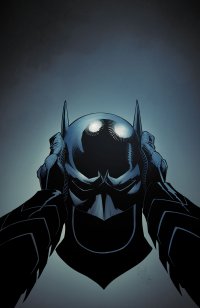
By Graig Kent
Well, that was surprising. No, not anything do do with the story itself, but rather the shocking $6.99 price tag on the cover of the book. I could go off on a rant about how only 1 of my 11 pulls this week had a price tag less than $3, but I think that conversation should always come down to one question: “Is it worth it?”
I’m a fan of what Scott Snyder is doing in the DC Universe, alongside Jeff Lemire and Brian Azzarello, (and I guess Geoff Johns, but he’s often part of DC’s problem) they’re showing what creator-driven, story-focused work in this big corporate trademark-perpetuating environment should look like. Snyder’s Batman has been driven by character exploration and definition, at every turn hammering home both who Bruce Wayne and Batman are, separately and together. Along the way, Snyder has managed to dole out some immensely fun action alongside expansion of the Bat-mythos and growing the Rogues Gallery. I mean, if you’re reading a Batman comic, isn’t that what you want?
Snyder’s current arc, “Zero Year”, like “Court of Owls” and “Death of the Family” before it, has become a tentpole for DC, a solid foundations to throw a tarp over and bring other titles underneath it. It’s one of those editorial decisions that frustrate fans of those other books, but on the merciful side, they leave Snyder to do his thing, to carry his story to fruition without having to accommodate the hop-ons. But “Zero Year”, unlike previous arcs, is a very generic concept, and could actually work to the advantage of many other books in the DC lineup.
What I like about Snyder’s “Zero Year” in Batman is his commitment to it. He’s taking a year out of telling “modern day” Batman stories and stepping back to the very early days in Bruce Wayne’s career. If Batman hadn’t been so solid under the team of Morrison, Snyder and Tomasi when the New 52 happened, the character could have been rebooted as Superman was and I would imagine it would look something like this. But at the same time, this also feels like a story Snyder wants to tell, something that he’s been thinking about, a story, reboot or not, he would be doing as a means to explore the character’s earliest time that doesn’t absolutely wreck what’s come before but also does something new and fresh with it.
I’m equally enjoying a Bruce Wayne who is not a grim prick or a grieving father, but a young man who knows his place in the world yet is still figuring out how to get there. It’s also nice to see Bruce smiling, and, jeepers, Batman having fun. It’s one of the great touches Snyder (and his amazing artistic companion, Greg Capullo) have been putting on Batman throughout this arc… he’s enjoying himself out there. Bruce/Bats gets a certain level of satisfaction out of taking out the bad guys, both in physically dominating them and outsmarting them. He’s not as cheery as Dick Grayson but he still has a sense of humour at this point (he rides a burly Red Hood thug down a flight of stairs with a “Yee Hah!” and what follows after is twisted genius).
This 54 page mini-epic wraps up the Red Hood arc that originally started a year ago in Batman‘s “zero” issue. If you’re familiar with Batman lore at all, you know the Red Hood to be the early guise the Joker used before Batman dumped him in a vat of chemicals, so you can kind of see where this story is going to wind up. But the thing is, this isn’t a Joker origin story, and Snyder resists the temptation to make it one. The focus still remains quite squarely on Bruce Wayne and Batman. The Zero Year setting allows for some very enjoyable sequences in and about a pre-/early-Batman Gotham, which is not something you see very often. The state of the City, Wayne Foundation and GCPD is all imagined with a dirty nostalgia, but Capullo, inker Danny Miki and colorist Dave McCaig ease up on the inks and dark tones to keep a warmer feeling to the proceedings.
Atypical for a Batman book, in Capullo’s Gotham a lot of the gothic elements are underplayed, to the point of irrelevance. Rather than being an urban nightmare and a terribly foreign place, Gotham looks much like it did in Christopher Nolan’s trilogy, like a massive urban city, familiar, that total Chicago/Pittsburgh hybrid. The lack of shadows is so very evident here, with Capullo and Miki keeping the lines tight and the black to a minimum, so as to allow more lighting into the scenes, while also perhaps insinuating that Bruce has not yet taken the shadows as his ally so much. All this space leaves more room for McCaig to fill, which he does with reds and yellows most prominently. The night sky of Gotham is more of a hazy deep purple than jet black, which any big city living person would recognize as being more true… the sky never feels dark in the city. So much of Zero year takes place during the day, signifying a fresher start for Batman, and a much different time in his life, making it a dramatically different Batman story than most.
If there’s flaws with this issue it’s in the filling of the blanks, either with exposition or with characters rationalizing their behavior. I’ve seen it done far worse, but there’s a level of acceptance when it comes to comic books, superhero universes in particular, that some things just don’t need to be said. Here,particularly in the back-up (which are usually so good) by Snyder, James Tynion, and Rafael Albuquerque, Alfred and Bruce discuss at length about how little Bruce should worry about protecting his identity. Part of the superhero trope is maintaining a secret identity and the slings and arrows that come with the maintaining a double life, to try and wash away any suggestion that people, reporters, police, etc would not question whether Batman was Bruce Wayne because of “acting” seems a gross oversimplification and miscalculation.
Coming back to the question that we started with… is it worth it? For me the answer is yes. If you’ve been enjoying the ride so far, then yes. If you’re on the outside ready to come in then yes. Even if you’ve missed the previous chapters of Zero Year, this still gives you enough of a bang to be satisfying. Even for $7. It’s the max limit mind you, but yes it’s worth it.
Rating: 




Out of a Possible 5 Stars
Adam Drinks the Indie Post-Apocalyptic Kool-Aid Two-For-One Special
The Shaolin Cowboy #1 (Dark Horse, $3.99)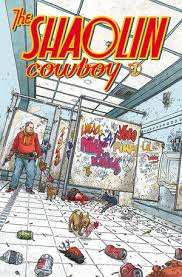
Multiple Warheads: Downfall (One-Shot) (Image, $7.99)
By Adam X. Smith
This week’s recommendations come courtesy of Page 45 Comics in Nottingham, easily my second favourite comic-book store in the Midlands.
You lucky people. This week’s picks are a couple of comics that would not be out of place being read by a pair of hipsters trolling the local rag markets for vintage Plumtree albums and worn copies of Deadline magazine. That’s right, folks – the indies are coming, and in both cases they’re books that have moved from one troubled company to a slightly less troubled one.
First on the chopping block is Dark Horse’s newly acquired Shaolin Cowboy by Geoff Darrow (formerly published by the Wachowski twins’ struggling Burlyman imprint). It opens for the benefit of everyone unfamiliar with the book (so basically everybody) with a two page synopsis of the story so far… in teeny-weeny eye-strain-o-vision no less, before giving us a rollicking 20 pages of hardcore, balls to the wall, shaolin monk-on-zombie action (context is everything).
The problem is, whilst Darrow as a visual storyteller is second to none, and his eye for meticulously detailed comic-book frames carries over from his work with Frank Miller in the Nineties, the lack of dialogue or narrative context makes it so that Shaolin Cowboy #1 is essentially a 20 page money-shot (again, context is everything).
And although the opening prose prologue does help with this – whilst managing to cram in as many silly puns and jokes about Obamacare as possible – it lacks any discernible link to the visuals. Viewed in isolation, neither one makes a ton of sense without the other, and while the lack of familiarity is understandable, it is kind of disappointing that such a good artist as Darrow didn’t think to maybe run this aspect by his editor or even another writer first.
For contrast, “Seed of Destruction”, Mike Mignola’s first arc of Hellboy, was scripted by John Byrne because at the time Mignola was inexperienced with the writing process, and that was 20 years ago – I think Darrow’s work here would most certainly have benefitted from a little collaboration with someone. This is not to say the book is bad or not fun; it was simply in need of a little fine tuning before it was ready for primetime.
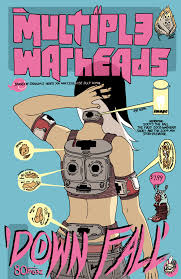 So it was a very happy Adam that opened Multiple Warheads: Downfall, the one-shot “zero issue” of Image’s recently acquired IP by Brandon Graham, ahead of its collected edition of the series later this year. What I got inside was an 80 page reprint of the three short stories Graham had previously published with Oni Press that is essentially the mutant offspring of Scott Pilgrim and Tank Girl. Set in a post-apocalyptic Russia following Wolf War III (which involved werewolves and aliens, apparently), it follows Sexica, an organ smuggler and her werewolf/mechanic boyfriend Nikoli, who living in the post-nuclear winter wastes of the Dead City and its surrounding environs as they attempt to make enough money smuggling weird body parts to rebuild an old Soviet midget car with a sentient boiler/engine and make a fresh start in the Impossible City, and have lots of kinky werewolf sex in the meantime.
So it was a very happy Adam that opened Multiple Warheads: Downfall, the one-shot “zero issue” of Image’s recently acquired IP by Brandon Graham, ahead of its collected edition of the series later this year. What I got inside was an 80 page reprint of the three short stories Graham had previously published with Oni Press that is essentially the mutant offspring of Scott Pilgrim and Tank Girl. Set in a post-apocalyptic Russia following Wolf War III (which involved werewolves and aliens, apparently), it follows Sexica, an organ smuggler and her werewolf/mechanic boyfriend Nikoli, who living in the post-nuclear winter wastes of the Dead City and its surrounding environs as they attempt to make enough money smuggling weird body parts to rebuild an old Soviet midget car with a sentient boiler/engine and make a fresh start in the Impossible City, and have lots of kinky werewolf sex in the meantime.
So yes, it’s a Tank Girl-clone, with a little FLCL thrown in for added quirkiness, but there’s an innocent charm and a joie de vivre to it that you can’t fake. The linework has the thickness and consistency of Jamie Hewlett or Brian Lee O’Malley, and makes use of the negative space inherent in the original strip’s black and white palette (the Image ongoing series is in colour) but without sacrificing incredible attention for detail within the frame. This is obviously a project Graham has fought to keep out of the cold. Plus there are lots of boobs and butts and werewolf penises. Yup, there’s no subtext here, no smarty-pants innuendo – just lots and lots of lo-fi black and white fucking. There’s a definite through-line from the Fleischer brothers to Robert Crumb to Hewlett directly to this comic. And God bless Brandon Graham for not being coy about it.
So there you go. Two highly recommended indie titles poking their heads above the soupy dreck of the mainstream. Enjoy. I drank the Kool-Aid, and I give them a hearty thumbs up.
The Shaolin Cowboy #1 Rating: 




Out of a Possible 5 Stars
Multiple Warheads: Downfall Rating:





Out of a Possible 5 Stars